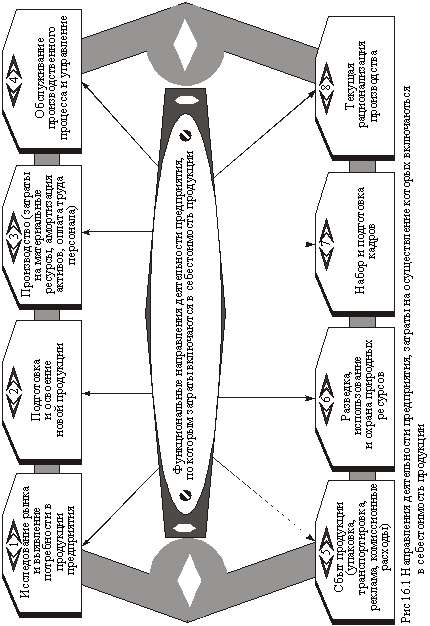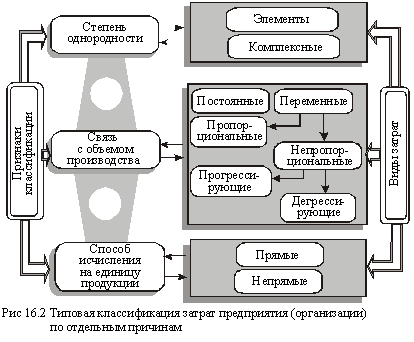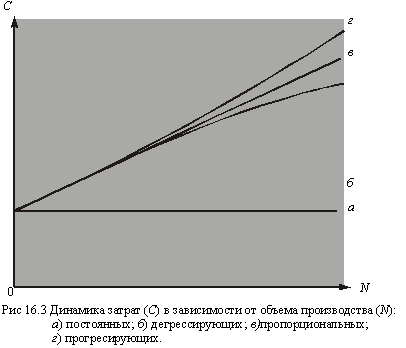home
 Economy Economy
 Economy of the enterprise - Pokropivny SF Economy of the enterprise - Pokropivny SF
|
Economy of the enterprise - Pokropivny SF
Chapter 16. Costs and Prices for Products (Services)
Key concepts and terms
Current (operating) costs; Cost of production; Variables and fixed costs; Proportional and disproportionate costs; Direct and indirect costs; Cost management; Critical volume of production; Total costs; Estimate of production; Elements of costs; Costing; Cost items (costs), price; Elements of the price; Types of prices and tariffs; Pricing; Factors of pricing; Methods of pricing .
16.1. General characteristics of costs for production (services)
Costs and production costs
Costs arise in the process of forming and using resources to achieve a specific goal. Usually they are multidirectional, divided into investment and current (operational), related to the immediate performance of the enterprise's main function (mission) - manufacturing products (providing services).
The current costs of factors of production are cyclical and continuous. The former are repeated with each cycle of manufacturing products (costs for materials, wages of natural producers, tools, etc.), the latter exist constantly and independently of production (maintenance of premises, facilities, equipment, management personnel, etc.).
The costs are, in terms of money and in kind, expressed. Planning and accounting for factors of production in kind (quantity, weight, volume, length, etc.) are important for the organization of the enterprise. However, to assess the results of this activity, the most important is the monetary measurement of costs, since it expresses the value of products (services).
It is necessary to distinguish between costs that form the value of products in a certain period (which are written off to it), and real cash payments. The first costs are associated with the production of products regardless of when the corresponding material resources or the employed labor are purchased. The second is payments for the acquired factors of production without taking into account the time of their use. Real cash payments serve the company's external turnover and labor payment.
It is clear that any costs are always aimed at achieving a certain result. Only this justifies their appropriateness. Concerning the production enterprise, this general principle of activity, which is the basis for determining the cost of production , is expressed by the formula "Imput - Output". The cost price of production is a monetary form of expenses for preparation of manufacture, manufacturing and sale of production.
Reflecting the level of costs for production, the cost of production comprehensively characterizes the degree of use of all the resources of the enterprise, and, consequently, the level of technology, technology and organization of production. The better the enterprise works, the more successfully it improves the equipment, technology and organization of production, intensively uses the resources used, the lower is the cost of production. Therefore, the cost of production is one of the important indicators of production efficiency. It is very closely related to the market price of products (tariffs for services). This is manifested in the fact that the cost price is the basis of the price of the goods (tariffs for services) and at the same time a constraint for production (no one will produce products whose prime cost will be higher than the market price).
For the calculation of the cost of production, the composition of the costs included in it is important. As you know, the costs of the enterprise are reimbursed at the expense of two own sources: prime cost and profit. Therefore, the question of the composition of costs included in the cost of production, is the issue of their distribution between these sources. The general principle of this distribution is that by including in the prime cost, those expenses that ensure a simple reproduction of all factors of production (objects and means of labor, labor and natural resources) are reimbursed. In accordance with this, the cost of production includes costs for certain functional areas of activity of the manufacturing enterprise (Figure 16.1).

It should be borne in mind that, for various reasons, in practice there is no complete correspondence between the actual costs of production and the cost of production. So, in accordance with the current order are not included in the cost of production, and reimbursed at the expense of profits and other sources of costs for the preparation and development of new products of mass production and mass production.
At the same time, there are such costs that are included in the cost price, but do not have a direct connection with the production: payment of the time for executing state duties by the employees of the enterprise, the shortened working day complex for adolescents, mothers with children under the age of one year,
Non-productive costs of the enterprise related to production (losses from marriage, shortages and damage to materials, losses from idle times, etc.) within the established norms are included in the actual cost of production, and losses from violation of the terms of contracts with other enterprises and organizations (penalties ) Are reimbursed at the expense of profit.
The composition of costs included in the cost of products (services) may vary slightly for various practical reasons. However, the general trend of such changes should be as fully as possible reflected in the cost price. This is possible, however, only on the condition of a full cost calculation, whereas in practice it is widely used to calculate the unit of output at incomplete costs.
Classification of costs
It is customary to distinguish between general (aggregate) costs and unit costs. Total costs - this is the cost of the entire volume of products for a certain period. Their amount depends on the length of the period and the number of manufactured products. The cost per unit of output is calculated as the average for a certain period, if the products are manufactured continuously or in batches. In a single production, the cost of the product is formed as an individual.
Since costs are a function of the volume of production with a certain elasticity, there is the concept of marginal costs . The marginal costs characterize their growth per unit of increment in the volume of production, i.e.,
 (16.1)
(16.1)
Where Зpr - marginal costs;
? ZO - increase in total costs;
? N - increase in the volume of production per unit of its natural measurement.
If the total costs are expressed as a function of the volume of output, then their limit level will be the first derivative of this function. This is the cost of the last unit of production for the time of manufacture. The marginal cost indicator is used in analyzing the feasibility of changing the volume of production.
In planning, accounting and analysis, the classification of costs by certain characteristics is used. The main ones are the degree of homogeneity of costs, the possibility of determining them for individual varieties of products, the link with the volume of production (Figure 16.2).

By the degree of homogeneity, costs are divided into elemental and complex . Elementary costs are uniform in composition, have a single economic content and are qualified as primary. These include: material costs, wages, deductions for social needs, depreciation, etc.
Complex costs are diverse in composition, cover several cost elements. They are grouped according to economic purpose when calculating and organizing in-house economic management (for example, general production, administrative costs, losses from product marriages, etc.).
Constant costs are a function of time, not of output. Their total value (within certain limits) does not depend on the number of products manufactured. It changes in leaps and bounds only with a significant change in the production and organizational structure of the enterprise (another subject of entrepreneurial activity). Constant costs include the maintenance and operation of buildings and structures, the organization of production and management costs. In the latter, so-called conditional -constant costs are singled out, which slightly (insignificantly) change due to an increase or decrease in the volume of production.
Variable costs are costs, the total value of which for a certain period depends on the volume of production. In turn, in their composition allocate costs proportional and disproportionate . Proportional costs vary directly in proportion to the volume of production. They include mainly the costs of raw materials, basic materials, components, as well as piece-rate wages of workers. The disproportionate costs are not directly proportional to the volume of production. They are subdivided into progressive and degressive .
Progressive costs increase more than production. They arise when an increase in the volume of production requires large expenditures per unit of output (the cost of piece-progressive wages, additional advertising and trade costs). The growth of degressing costs lags behind the increase in output. Degressive are usually the costs of operation of machinery and equipment, a variety of tools (accessories), etc.
In Fig. 16.3. Graphically shows the dynamics of the total permanent and variable costs.

The dynamics of costs per unit of output looks different. It is not difficult to build it on the basis of certain regularities. In particular, the variable proportional costs per unit of output remain at the same level regardless of the volume of production. On the graph, the line of these costs will be parallel to the abscissa. Constant costs per unit of output with an increase in its total volume decrease in the parabolic curve. For regressing and progressive costs, the same dynamics remains, only the more pronounced.
In practical calculations, the overall dynamics of variable costs is simplified, assuming their entire population is proportional. This greatly facilitates the analysis and forecasting of costs.
Of no small practical importance is the division of costs into direct and indirect costs by the method of calculating them per unit of output. Direct costs are directly related to the manufacture of certain types of products and can be calculated directly to its physical unit. If one type of product is produced at the enterprise or its structural subdivision, then all costs are direct. Indirect costs (wages of serving management personnel, maintenance and operation of labor means) can not be directly determined for individual varieties of products. The division of costs for direct and indirect depends on the level of specialization of production, its organizational structure, the methods of rationing and accounting applied at the enterprise. Increase of a part of direct expenses in a total sum of expenses raises accuracy of calculation of the cost price of a unit of production, strengthens economic bases of management.


Comments
When commenting on, remember that the content and tone of your message can hurt the feelings of real people, show respect and tolerance to your interlocutors even if you do not share their opinion, your behavior in the conditions of freedom of expression and anonymity provided by the Internet, changes Not only virtual, but also the real world. All comments are hidden from the index, spam is controlled.